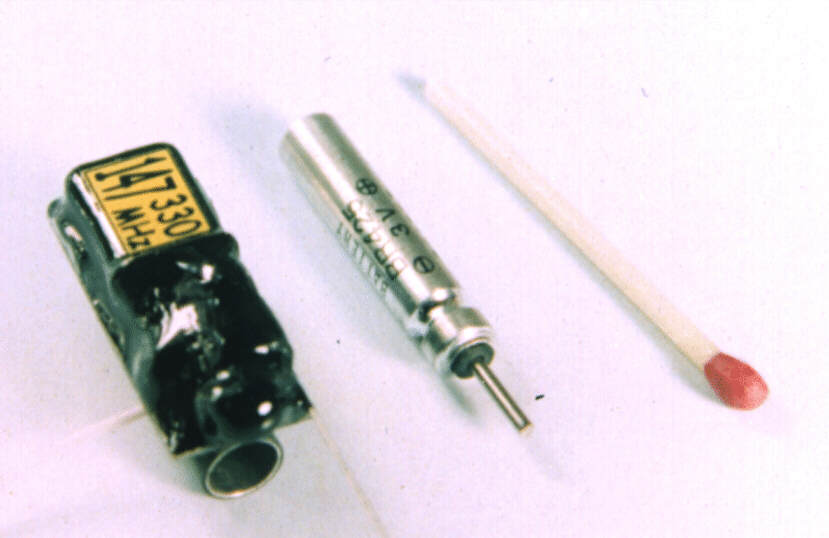
Model radio tracker

The device is really tiny. It weighs just 1.5 grams. This is a 3X magnified size picture showing the locator (left) and a battery (center) compared to a match (right). The battery holder is the small tube on the bottom of the locator.
Description:This locator is a tiny radio transmitter designed to help the retrieval of free flight models in windy days, with strong thermal activity and whenever the model is difficult to find after landing. The tracker, installed on the model, will be transmitting its signal for days, being promptly locatable through a hand-held receiver. It is crystal controlled, and works in VHF band emitting an unmodulated impulsive carrier wave (CW). Through this smart technique, the signal is periodically transmitted for a short time (about 1/20th second every second) and this yields a very long battery duration.
Receiver requirements: A good VHF receiver, scanner or transceiver is needed. Probably, the cheapest solution is a ham-band (radio-amateur) transceiver. A 5 KHz tuning step, the "squelch'" function and the "S-meter" are required too. A number of very popular models is available from YAESU, CTE, iCOM, KENWOOD and many else.
Positioning the tracker: The tracker should be installed on the model with the antenna straight and vertical, coming out of the upper side of the fuselage to have a good propagation when the model is placed on the ground.
Tuning-in the receiver: Tune-in the receiver on the exact frequency of the tracker, then completely exclude the "squelch" to hear the typical ground noise (no-signal noise). Then adjust the volume on the receiver around the middle position and turn the tracker on by placing the battery into its holder. Short and regular pulses will start being heard on the receiver. Set the volume as desired and accurately adjust the squelch up to the exact point where the ground noise stops: the signal 'breaks' the squelch and the pulses will sound like short and regular knocks.
Range: with this tracker in combination with a good hand-held transceiver using its standard short rubber antenna, the signal of a model in flight will be received from many kilometers, and the ground range will be of about 500/700 meters in a scenario free from significant obstacles. The range can be increased up to 10/15 Kilometers in flight and 1/1.5 Kilometers on the ground by providing the receiver with a good multi-element directional antenna mounted on a short pole (e.g. HB9CV type, 6 dB gain, 2 foldable elements).
Retrieval techniques: an easy-to-learn technique based on the shielding effect caused by our body (body shielding) while holding the receiver, covers most real situations. Please download the user's manual to learn more about this and other commonly used techniques.
Battery duration: the lithium battery used in this microtransmitter has a typical lifetime of 190 hours, i.e. over one week in safety conditions, which ensures a good safety margin to search the model, should the retrieval take time for any reason.
![]() User's Manual
download (english)
User's Manual
download (english)
![]() User's
Manual download (italian)
User's
Manual download (italian)